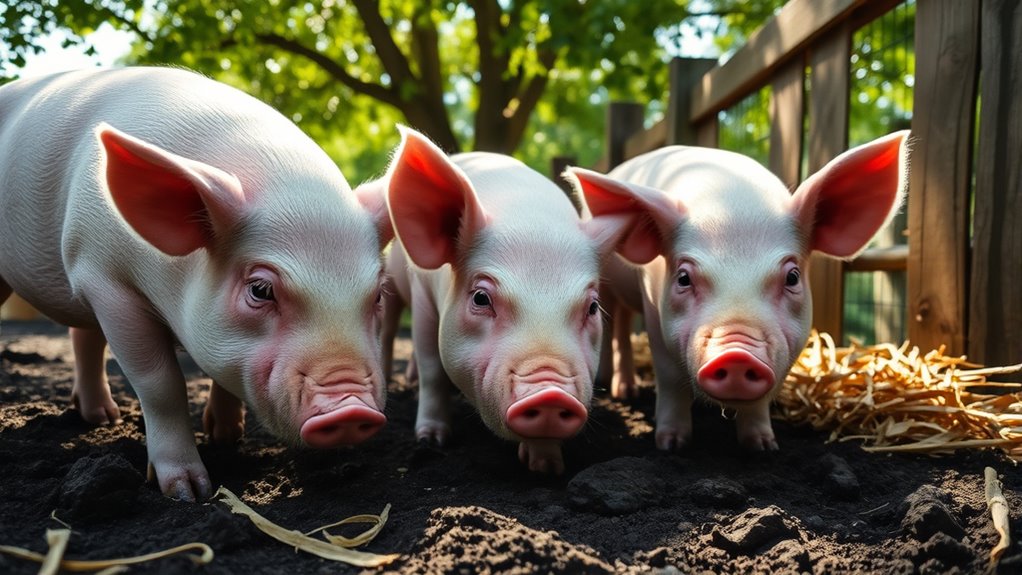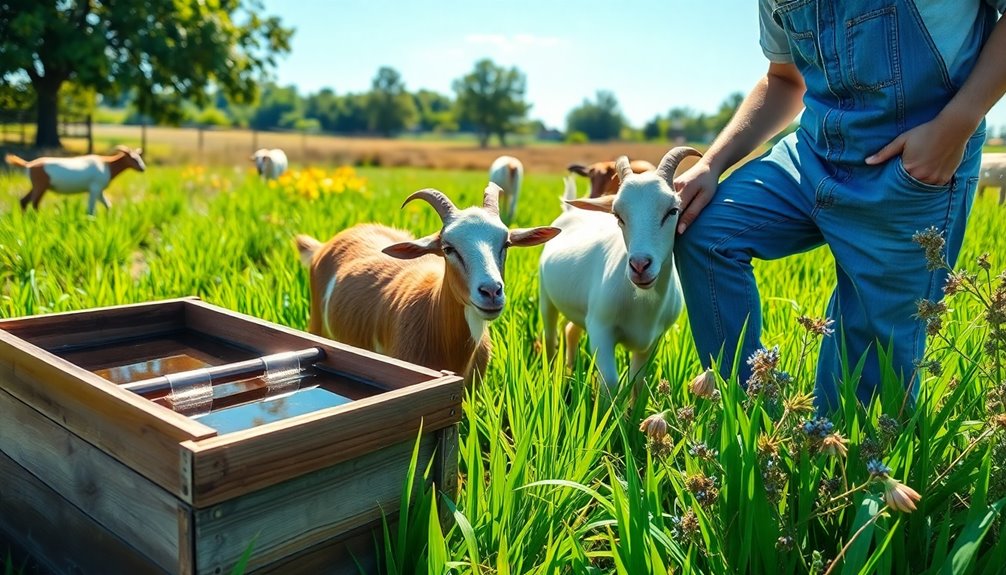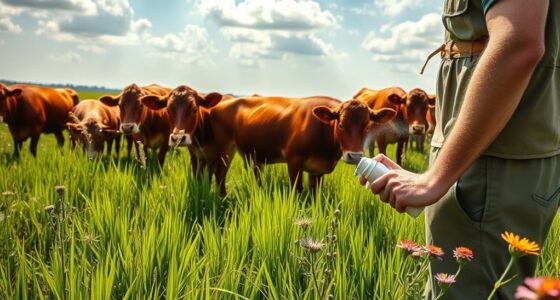To raise pigs on a homestead, focus on providing proper housing with good ventilation, dry bedding, and biosecurity measures. Keep them healthy by maintaining clean environments, offering balanced nutrition suited to different age groups, and implementing vaccination and parasite controls. Regularly check for signs of illness and observe their behavior. Good skin care and consistent management help ensure strong, healthy pigs. Keep exploring these essential tips to build a successful small-scale pork operation.
Key Takeaways
- Ensure proper housing with good ventilation, dry bedding, and biosecurity measures to protect pigs from weather and disease.
- Provide a balanced, age-appropriate diet with fresh water, avoiding spoiled or toxic feed sources.
- Regularly monitor pig health for signs of illness, maintaining cleanliness and skin care routines.
- Incorporate vaccination and parasite control to prevent disease and promote overall well-being.
- Observe pigs consistently, adjust feeding and care practices, and maintain clean living conditions for optimal growth.

Raising pigs on a homestead can be a rewarding way to produce your own meat and improve self-sufficiency. To guarantee your pigs thrive, focusing on pig health is essential. Healthy pigs grow faster, produce better meat, and are less susceptible to illness. Monitoring their health involves regular checks for signs of disease, maintaining clean living conditions, and providing appropriate vaccinations and parasite control. Recognizing early signs of illness, such as lethargy, loss of appetite, or abnormal behavior, helps you intervene before problems escalate. Good pig health also depends on proper housing that offers protection from extreme weather, adequate ventilation, and dry bedding. Keeping the environment clean minimizes the risk of infections and encourages overall well-being. Regular use of exfoliating acids like glycolic acid can enhance skin health, which is important if pigs are exposed to harsh environmental conditions. Implementing biosecurity measures can further prevent the introduction and spread of diseases within your herd. Additionally, incorporating preventative health practices can reduce the need for treatments and support overall herd vitality.
Feeding strategies play a critical role in maintaining pig health and ensuring ideal growth. You need to provide a balanced diet that meets their nutritional needs at different growth stages. Young piglets require a high-protein starter feed to support rapid growth, while older pigs need a diet rich in energy, fiber, and minerals. Incorporate grains, such as corn or oats, along with quality protein sources like soybean meal or fish meal. Fresh water should always be available, as hydration is indispensable for digestion and overall health. You might also consider supplementing their diet with vegetables or kitchen scraps, but avoid feeding them anything toxic or moldy. Adjust feeding amounts based on their age, weight, and activity level to prevent overfeeding or undernutrition. Overfeeding can lead to obesity and related health issues, while underfeeding stunts growth and weakens the immune system. Also, rotating different feed sources can help prevent nutritional deficiencies and keep your pigs interested in their diet.
When developing your feeding strategies, it’s important to observe your pigs regularly. Notice how they respond to different feeds, and make adjustments as needed. Some pigs might have specific dietary preferences or tolerances, so tailoring their diet can improve their health and growth rates. Avoid sudden changes in feed to prevent digestive upset. Also, keep a close eye on the amount and quality of feed, storing it properly to prevent spoilage and pests. Using high-quality feed ensures that your pigs get the nutrients they need, which translates to healthier pigs and better meat quality. Proper nutrition and health management are interconnected and vital for a successful homestead operation.
Frequently Asked Questions
How Do I Prevent Pig Diseases in a Small-Scale Setup?
To prevent pig diseases, you should implement strict biosecurity measures like limiting visitors, disinfecting equipment, and controlling access to your pigs. Keep your pigs healthy by ensuring proper nutrition and minimizing stress. Additionally, stay up-to-date on disease vaccination schedules to protect against common illnesses. Regular health checks and quarantine new pigs help prevent outbreaks, so you can maintain a healthy, productive small-scale pig operation.
What Are the Best Pig Breeds for Beginners?
Think of choosing pig breeds as selecting the building blocks of your homestead’s future. For beginners, breeds like Yorkshire, Duroc, or Berkshire act as reliable roots, thriving with proper pig breeding and a balanced pig diet. These breeds are hardy, friendly, and forgiving, making your first experience smoother. By starting with these versatile pigs, you’ll lay a solid foundation for successful small-scale pork production, growing confidence with each step.
How Much Space Is Needed per Pig?
You’ll want at least 8 to 10 square feet of space per pig to make certain of good pig behavior and proper pork nutrition. Adequate space helps prevent stress and aggressive behavior, promoting healthier growth. Pigs are social animals that need room to move and forage. Providing enough space not only improves their well-being but also results in better quality pork. Keep in mind, more space generally leads to happier, healthier pigs.
What Is the Average Lifespan of a Homestead Pig?
You’re curious about how long a homestead pig lives, right? On average, pigs live around 15 years, but many are slaughtered earlier for pork preservation. To guarantee good piglet nutrition and health, provide a balanced diet and proper care. Proper management can extend their lifespan and improve meat quality. Keep in mind, the lifespan varies based on breed, purpose, and how well you care for them.
How Do I Ethically and Sustainably Slaughter Pigs?
Imagine gently closing the chapter of a pig’s life with respect and compassion. To guarantee ethical slaughter and humane processing, you should use methods like stunning to minimize pain and stress. Always follow local laws and guidelines, and work with trained professionals when needed. Your care and respect turn a difficult task into a meaningful act, honoring the animal’s life and supporting sustainable, ethical homesteading practices.
Conclusion
Raising pigs on your homestead can be incredibly rewarding and sustainable. Did you know that small-scale pig farms can produce up to 60% of their own pork needs? With proper care and attention, you’ll enjoy fresh, tasty meat and a stronger connection to your food. Keep learning and experimenting, and you’ll find raising pigs to be a fulfilling part of your homesteading journey. Start small, stay consistent, and watch your pigs thrive!










